|
|
|
|
|
|
|
|
|
|
|
|
|
|
|
|
|
|
|
|
|
|
|
|
|
|
|
|
|
|
|
|
|
|
|
|
|
|
|
|
|
|
|
|
|
|
|
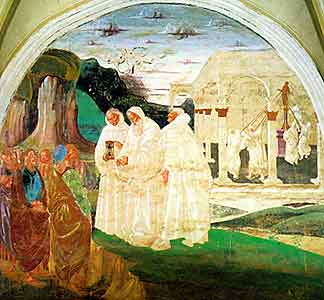 |
|
|
|
|
|
|
|
|
|
|
|
|
|
|
|
|
|
|
|
|
|
|
|
|
|
|
|
|
|
|
|
|
|
|
|
|
|
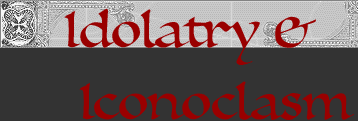 |
|
|
|
|
|
|
|
|
|
|
|
|
|
|
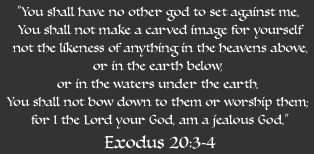 |
|
|
|
|
|
|
|
|
Iconoclasm
accompanies conversion in a fresco of St. Benedict by Lucca Signorelli (1441-1523).
While St. Benedict preaches the gospel, monks are busy destroying a pagan idol.
|
|
|
|
|
|
|
|
|
|
|
Idolatry
Strictly speaking
idolatry denotes the worship of deity in a visible form, whether these images
are symbolical representations of a “true” God or of a “false”God
they are divinities which have been made the objects of worship. Christianity
was built in part on pre-existing Roman and Judaic cultures. Episodes of idolatry
are numerous throughout the Old Testament. The first and second commandments
of Moses (Exodus 20:3-4) prohibit idolatry of every form. Individuals
and communities were equally amenable to the |
|
|
|
|
|
|
|
rigorous
code as idolaters were denounced and punished. Idolatry was dangerous to early
Jews and Christians because of its association with paganism.
|
|
|
|
|
|
|
|
|
|
|
|
|
|
|
|
|
|
|
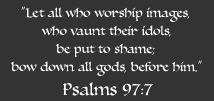 |
|
|
|
|
|
|
| The
first allusion to idolatry or idolatrous customs in the Bible is the account
of Rachel stealing her fathers teraphim (Genesis 31:19) “When Laban
the Aramaean had gone to sheer his sheep, Rachel stole her father’s household
gods...” During their long stay in Egypt, the Israelites defiled themselves
with the idols of the land and it was long before the taint was removed. They
clamored for some visible shape in which they |
|
|
|
|
|
|
|
|
|
|
|
|
|
|
|
|
 |
|
|
|
|
|
|
|
|
|
|
|
|
|
|
might
worship God who had brought them out of Egypt until Aaron made the golden calf,
the embodiment of Apis and the emblem of the productive power of nature (Exodus
32). |
|
|
|
|
|
|
|
|
 |
|
|
|
|
|
|
|
Under
Samuel administration idolatry was publically renounced (1 Samuel 7:3-6) “If
your return to the lord is wholehearted, banish the foreign gods and the Ashtaroth
from your shrines; turn to the Lord with heart and mind and worship him alone,
and he will deliver you from the Philistines.” but all of this was
forgotten during the reign of Solomon. “When he grew old, his wives
turned his heart to follow other gods, and he did not remain wholly loyal to
the Lord his God as his father David had been.” (1 Kings 11:4) |
|
|
|
|
|
|
|
|
|
|
|
|
|
|
|
|
 |
|
|
|
|
|
|
|
|
|
|
|
|
|
|
|
|
|
|
|
|
|
|
|
|
|
|
|
|
|
|
|
|
|
The
aged King Solomon, surrounded by his wives, kneels to worship an idol, represented
as a pagan figure on a free-standing column, by Johann Teufel, 1572. |
|
|
The Christian church
never denied that idolatry should be condemned, however, the problem was how
to define and separate proper visual representation from incorrect idols and
how to operate within those boundaries. The fixing of faith in images was crucial
to the practice of Pre-Reformation Christianity. Salvation depended on a system
of iconic signs. Representation presented an illusion of coherence in an unstable
world. |
|
|
|
|
|
|
|
|
|
|
|
|
|
|
|
|
|
|
 |
|
|
|
|
|
|
|
|
|
|
|
|
|
|
|
|
|
|
|
|
|
|
|
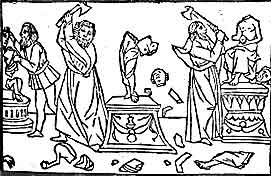 |
|
|
|
|
|
|
|
|
|
|
|
|
|
|
|
|
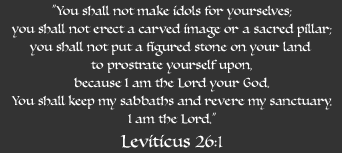 |
|
|
|
|
|
|
|
|
|
|
|
|
|
|
|
|
|
|
|
|
|
|
|
|
|
|
|
|
|
|
|
|
|
The
destruction of 'pictures' and 'molten images' from an Italian Bible, c. 1490.
|
|
|
|
|
|
|
|
|
|
|
|
|
|
|
|
Iconoclasm
The prohibition
and destruction of religious imagery is as much a part of the history of religion
as the shaping and veneration of these representations. Iconoclasm is an intense
religious phenomenon that can be defined as any movement against the religious
use of images, especially those dealing with figural representation. In a conventional
sense, iconoclasm is the destruction of paintings, sculpture and other disapproved
images and along with this disapproval can also be included the buildings which
contained and displayed such elements and the ceremonies themselves which were
performed inside.
|
|
|
|
|
|
|
|
|
|
|
|
|
|
|
|
|
|
|
|
|
|
|
|
|
|
|
 |
|
|
|
|
|
|
|
|
|
|
|
|
|
|
|
Iconoclasm
implies a spirited attack that can be verbally violent or actively violent on
certain unacceptable images, but does not totally repudiate all images, which
is iconophobia. It is hostile to false art but not anti art, since its hostility
implies a true and acceptable art, applied to laudable purposes. Iconoclasts
didn’t view disapproved images in terms of works of art. The sanctioning
of images and defining the proper function of religious imagery, in terms of
totemic value versus ornamental purpose, could lead the viewer to either the
salvation of heaven or the eternal damnation of hell. |
|
|
|
|
|
|
|
|
|
|
|
|
|
|
|
|
|
|
|
|
|
King
Josiah, abolisher of idols, from an Italian Bible, c. 1490. |
|
|
|
|
|
|
|
|
|
|
|
|
|
|
|
|
|
|
|
|
 |
|
|
|
|
|
|
|
|
|
|
|
|
|
|
|
|
|
|
|
|
|
|
|
|
|
|
|
|
|
|
|
|
|
|
|
|
|
|
|
|
|
|
|
|
|
|
|
|
|
|
|
|
|
|
|
|
 |
|
|
|
|
|
|
|
|
|
|
|
|
|
|
|
|
|
|
|
|
|
|
|
|
 |
 |
 |
 |
 |
 |
 |
 |
 |
 |
 |
 |
 |
 |
 |
 |
 |
 |
 |
 |
 |
 |
 |
 |
 |
 |
 |
 |
 |
 |
 |
 |
 |
 |
 |
 |
 |
 |
 |
 |
 |
 |
 |










